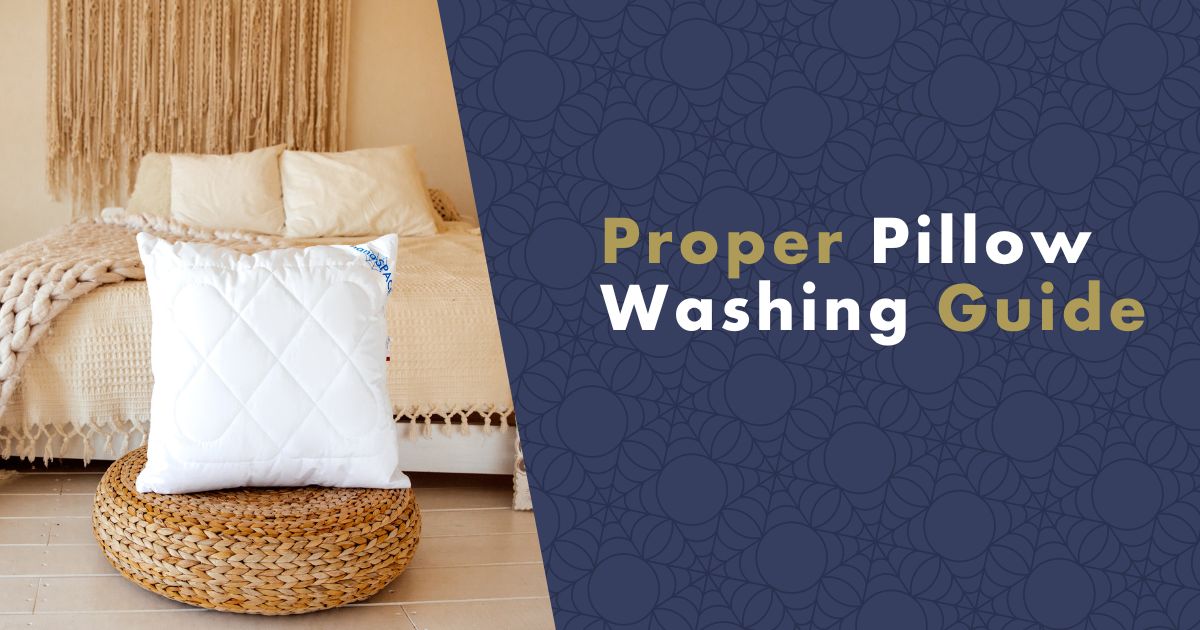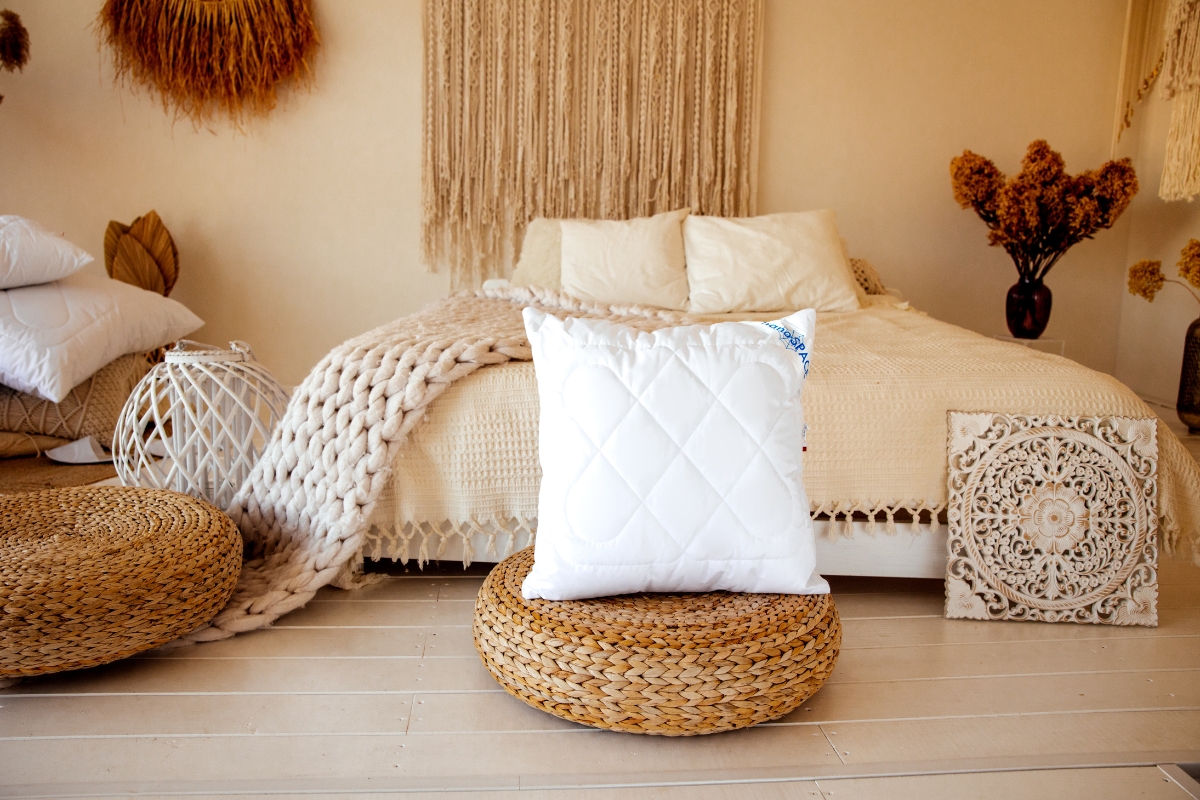Achieving a good night's sleep is essential for our overall well-being, and one often underestimated factor contributing to this is the condition of our pillows. For allergy sufferers, selecting the right pillow material and maintaining proper hygiene are crucial elements in creating a comfortable and healthy sleep environment. In this comprehensive guide, we will delve into the intricacies of washing different pillow types, with a focus on feathers, microfiber, and hollow fiber. Whether you're looking to alleviate allergies or simply enhance the longevity of your pillows, this Pillow Washing Guide will provide valuable insights to ensure a restful night's sleep.

Why Wash Pillows?
The pillow on which we rest our heads every night can harbor a small microscopic ecosystem. After two years of use, up to a tenth of its weight can be made up of dust mites. If you have a dust mite allergy, it is recommended to use pillows with a microfiber membrane that prevents mites, allergens, bacteria, and viruses from passing through.
A study conducted by the Airmid Health Group revealed that the most common inhabitants of regular pillows are dust mites. Their feces and dead bodies can contribute to allergic reactions and respiratory problems.
Every pillow examined by the Airmid Health Group team contained bacteria, including the notorious Staphylococcus aureus, also known as golden staph. This bacterium can cause a wide range of infections, from mild skin inflammation to life-threatening sepsis. Several pillows were also found to contain Escherichia coli, which is often associated with diarrhea.
Half of the examined pillows also harbored molds. Among them, Aspergillus, a common allergen and asthma trigger, was found. Another mold discovered was Candida, which can cause topical infections, especially on the skin and mucous membranes.
Although the presence of these microorganisms may sound concerning at first glance, it is important to realize that their presence is relatively common in our environment. The key is proper maintenance and regular cleaning of pillows, which helps keep these microscopic inhabitants under control.
How Often to Wash Pillows?
Pillows should be washed at least twice a year. However, if you have pillows with a microfiber membrane, maintenance is much easier as dust and mites cannot penetrate the filling. In such cases, it is sufficient to vacuum or wipe the surface of the pillows every six months and wash them only if visibly soiled. When used more frequently, such as during an illness, it is advisable to wash the pillows more often.
Preparing Pillows for Washing
If your pillows have zippers, it is recommended to remove the filling before washing. Washing the entire pillow with the filling intact may cause it to clump and lose its fluffiness. Also, check the label instructions to ensure that the pillow is suitable for machine washing.

Why Not Wash Pillows Too Frequently?
While washing pillows is an important part of their maintenance, excessive washing can have a negative impact on their lifespan and quality. Frequent washing can also be hazardous to your health.
- Mold Growth: Excessive washing can lead to incomplete drying of the filling, resulting in mold growth inside the pillows. This is why frequent washing is not recommended for allergy sufferers concerned about dust mites.
- Material Wear and Tear: Each wash causes some wear and tear on the pillow's material. If pillows are washed too often, the material can deteriorate quickly, leading to thinning or even damage to the pillow.
- Time Consumption: Frequent pillow washing can be time-consuming. Pillows require specific care during washing and drying, which can be burdensome if the procedure needs to be repeated too often.
Washing Different Types of Pillows
Different types of pillows require specific care during washing. Let's explore the washing methods for common pillow types:
Hollow Fiber Pillows
These pillows, filled with hollow fiber, are popular for their softness and affordability. Here's how to wash them:
- Place the pillows in the washing machine, ensuring they are evenly distributed.
- Use a gentle cycle with warm water and add a small amount of mild detergent.
- To prevent clumping, add a couple of tennis balls or dryer balls to the machine.
- After washing, thoroughly rinse the pillows to remove all detergent residue.
- To dry, tumble dry on low heat or air dry in a well-ventilated area. Ensure the pillows are completely dry before use.
Feather Pillows
Feather pillows provide luxurious comfort but require special care. Follow these steps to wash them:
- Check the care label to determine if your feather pillows are machine washable. Some may require professional cleaning.
- If machine washable, place the pillows in the washing machine with a small amount of gentle detergent.
- Use a gentle cycle with warm water and perform an extra rinse to remove all detergent.
- To dry, tumble dry on low heat or air dry in a well-ventilated area. Add dryer balls or clean tennis balls to fluff the pillows during drying.
Allergy-Proof Pillows with Nanofiber Membrane
Allergy-proof pillows with a nanofiber membrane are designed to prevent dust mites, allergens, bacteria, and viruses from penetrating the filling. Here's how to wash them:
- Machine wash the pillow covers once a year in warm water using a mild detergent without chlorine or phosphates.
- If your pillows have zippers or removable covers, you can wash only the covers. The filling should not require frequent washing due to the protective membrane.
- For maintenance between washes, wipe the surface of the pillows with a damp cloth or vacuum with an upholstery attachment to remove any surface contaminants.
Memory Foam, Water, or Spring Pillows
These specialized pillows often have non-removable covers and require alternative cleaning methods. Here's what you can do:
- Check the care label for any specific instructions regarding cleaning the pillow cover. Some covers may be machine washable.
- If the pillow cover is not washable, spot clean any stains using a mild detergent and a damp cloth.
- To freshen up the pillow, sprinkle baking soda on the surface, let it sit for a few hours, then vacuum it thoroughly.
- If your memory foam, water, or spring pillows have a removable cover, follow the care instructions provided to wash the cover separately.
Choosing the Right Detergent
When it comes to washing pillows, it's important to use gentle and eco-friendly laundry detergents that will safeguard the fabric and prolong its lifespan. Opt for environmentally friendly products that do not contain phosphates or peroxide. Avoid using fabric softeners on pillows as they can leave residues and reduce their fluffiness.
#produkty#https://www.nanospace.store/ecological-detergents/
Step-by-Step Pillow Washing Guide
Let's now take a closer look at the step-by-step process of washing pillows:
Step 1: Preparing the Pillow
Start by removing the pillow filling, which may be stored in a separate cover or loosely inside the pillow itself. It's recommended to wash the filling only when absolutely necessary. If your pillow does not have a zipper, wash it as a whole unit.
Step 2: Loading the Pillows into the Washing Machine
Properly distribute the pillows in the washing machine drum to ensure even washing. If you are washing a single pillow, it's advisable to add a towel or two to balance the load and promote effective cleaning.
Step 3: Choosing the Right Washing Program
Different types of pillows require specific washing settings. Refer to the care label on your pillows for instructions and select the appropriate washing program on your machine accordingly. It's essential to follow the recommended guidelines to avoid damaging the pillows during the washing process.
Step 4: Drying the Pillows
After washing, it's crucial to allow the pillows to dry thoroughly. Moist pillows can become breeding grounds for bacteria and molds. Depending on the type of pillow, follow these guidelines:
For allergy-proof pillows with a nanofiber membrane, avoid using a dryer. Instead, refer to the pillow's label for specific instructions on air drying or other suitable methods.
For other types of pillows, consult the care label to determine if machine drying is recommended. If allowed, tumble dry the pillows on low heat or air dry them in a well-ventilated area. Consider using dryer balls or clean tennis balls to help fluff the pillows during drying.
Tip: Can You Use a Dryer?
While some pillows can be safely dried in a machine dryer, it's important to read the pillow's label carefully to determine if it's suitable. For example, pillows with nanofiber membranes designed for allergy sufferers should never be dried in a dryer. Always prioritize the manufacturer's instructions to ensure the best care for your pillows.
By following these step-by-step instructions, you can effectively clean your pillows, remove unwanted odors and allergens, and extend their lifespan. Remember, a clean and well-maintained pillow contributes to a comfortable and healthy sleep environment.
FAQ - Frequently Asked Questions
How often should pillows be washed?
The frequency of washing pillows depends on the type of pillow and the intensity of its use. As a general guideline, pillows should be washed at least once a year. However, pillows filled with hollow fibers are recommended to be washed every six months. Pillows with a nanofiber membrane do not require as frequent washing since dust mites and allergens do not penetrate them.
At what temperature should pillows be washed?
The typical washing temperature for pillows is 60°C, which helps eliminate microorganisms. Pillows filled with hollow fibers can be washed at temperatures up to 95°C. On the other hand, pillows with a nanofiber membrane should be washed at 40°C to prolong their lifespan. Higher temperatures are unnecessary as mites and other microorganisms cannot penetrate them.
Can pillows be dried in a dryer?
It depends on the type of pillow. However, it's important to use a special program and monitor the temperature. Feather pillows, for example, can be dried at a maximum temperature of 80°C. However, pillows with a nanofiber membrane should never be placed in a dryer.
How often should pillows be aired out?
Airing out pillows is an important part of their maintenance. Regardless of the pillow type, it is recommended to regularly air them out every 2-3 months to naturally remove excess moisture from the filling.
Can pillows be ironed or dry cleaned?
In general, pillows should not be ironed or dry cleaned. This recommendation applies to all types of pillows, including those filled with hollow fibers, feather pillows, and pillows with a nanofiber membrane.
Can feather pillows be washed?
Yes, feather pillows can be washed in a washing machine, but caution must be exercised. It is recommended to wash them on a gentle cycle with a maximum water temperature of 40°C. Proper drying of feather pillows is also important.
Do I need to use special laundry detergents for washing pillows?
In general, pillows can be washed with regular laundry detergents. However, for certain specific types of pillows, such as feather pillows, it is recommended to use mild laundry detergents. For pillows with a nanofiber membrane, detergents containing phosphates and peroxide should be avoided.
What should I do if the pillow still has an odor after washing?
If the pillow continues to have an unpleasant odor after washing, it may indicate the need for further cleaning or that it's time to replace the pillow. For allergy sufferers, it is generally recommended to replace pillows every two years or to use hypoallergenic pillows with a nanofiber membrane.
How can I tell if a pillow is washable?
If there is a washing machine symbol on the care label, the pillow can be washed in a washing machine. Pillows filled with hollow fibers, those with a nanofiber membrane, or feather pillows are usually suitable for machine washing.
How often should pillows with a nanofiber membrane be washed?
Pillows with a nanofiber membrane should be washed once a year. The membrane is designed to prevent dust and mites from penetrating the filling, reducing the need for frequent washing. Washing is recommended when visible dirt or stains are present.
Can pillows with a nanofiber membrane be washed in a washing machine?
Yes, pillows with a nanofiber membrane are designed to be machine washable, using a temperature of 40°C.
Can pillows with a nanofiber membrane be dried in a dryer?
No, pillows with a nanofiber membrane should not be dried in a dryer as it could damage the nanofiber membrane.
How should pillows with a nanofiber membrane be washed?
When washing pillows with a nanofiber membrane, it is important to follow a few guidelines. The pillow should be washed on a gentle cycle with a low temperature, up to a maximum of 40°C. It is recommended to use mild laundry detergents and avoid using aggressive bleaching agents.

